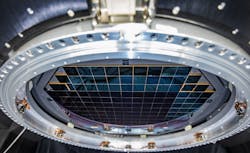Technicians at the SLAC National Lab are assembling and testing components of a camera capable of taking 3,200-megapixel digital photos that will be used at the Vera C. Rubin Observatory on a mountaintop in Chile. There, the LSST (Legacy Survey of Space and Time)
camera will spend every night for 10 years taking a panoramic image of the entire southern sky, one every night. These images will be so large that it would take 378 4K ultra-high-definition TV screens to display just one of them; their resolution will be high enough to see a golf ball from about 15 miles away. These and other properties will soon drive unprecedented astrophysical research.
The team has finished assembling the focal plane, the imaging sensor for the camera. It consists of 189 individual charged-coupled-device (CCD) sensors, each of which contributes 16 megapixels to the final image. The CCDs were bundled, nine at a time along with their supporting electronics, inside square sub-assemblies called “science rafts.” Twenty-one of these 20-lb, two-foot tall, $3-million rafts will take images of distant galaxies and stars, while four other specialty rafts with only three sensors will help focus the camera and synchronize the telescope with the Earth’s rotation.
The technicians took a year developing the installation procedures for the rafts, then took another six months to install them. They ended up building a specialized gantry that let them pull the rafts into place. It was still a tricky operation because they had to maintain gaps between the rafts no wider than the width of five human hairs (about 0.005 in.). The rafts are also fragile and can crack if they touch one another.
The resulting two-foot wide focal plane contains 3.2 billion pixels, and pixels are only about 10 microns wide. The plane is extremely flat, varying by no more than 0.0001 in. It must be housed in a cryostat that keeps the rafts at their operating temperature: 150°F. All of this lets the camera take sharp images in high resolution. It can capture a portion of the night sky equivalent to 40 moons and spot objects 1/100 millionths as bright as what the naked eye can see. According to the researchers, this translates into being able to see a lit candle from “thousands of miles away.”
Over the next few months, the team will install the cryostat and focal plane into the camera body, then add a shutter, a changeable filter and what is said to be the world's largest optical lensesinto the camera: a 5.1-ft diameter one dubbed L-1 and a 3.2 ft one called L-2. They were built over the past five years by Ball Aerospace and Arizona Optical Systems.
By mid-2021, the SUV-sized camera will go through for final testing before it gets sent to Chile.
To learn more about the LSST telescope, check out the video below:


